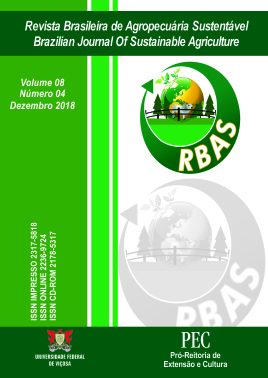INCIDENCE AND POPULATION FLUCTUATION OF SPITTLEBUGS ON THREE PERENNIAL GRASSES: ON-FARM ASSESSMENTS
DOI:
https://doi.org/10.21206/rbas.v8i4.3045Palavras-chave:
varietal resistance, Cynodon spp., Axonopus catharinensis, integrated management.Resumo
Significant population outbreaks of spittlebugs (Hemiptera: Cercopidae) have been observed in perennial grasses (Poaceae) established in farms in South of Brazil. This situation is worrying local producers in relation to the continuous supply of forage due to the significant damage caused by this pest species complex. Thus, this study aimed to evaluated the incidence and populational fluctuation of spittlebugs (Hemiptera: Cercopidae) in three perennial grasses [Cynodon dactylon cv. Jiggs, C. dactylon cv. Tifton 85, and Axonopus catharinensis cv. SCS 315 Catarina Gigante (Poales: Poaceae)] in an experimental farm under semi-intensive milk production system. For this purpose, weekly counts of the foam produced by the spittlebugs nymphs were carried out in 10 points of 0.25 m2 (0.5 x 0.5 m) each, totalizing 35 assessments from the beginning of September 2015 to the end of April 2016. The incidence of spittlebugs was significantly different among the three perennial grasses. Lower incidence of spittlebugs was observed on A. catharinensis cv. SCS 315 Catarina Gigante (4.91 nymphs foam m-2 week-1 in average), which is a natural species from South Brazil, followed by C. dactylon cv. Jiggs (6.51 nymphs foam m-2 week-1 in average) and by C. dactylon cv. Tifton 85 (7.58 nymphs foam m-2 week-1 in average). Moreover, three characteristic population peaks of spittlebugs was observed: the first in the end of September, the second in the middle of December, and the third in February early. However, the number of nymphs foam of spittlebugs was not significant correlated with the climatic parameters (precipitation, average temperature, and relative humidity) of periods (week) prior to the weekly sampling times. In light of these findings, A. catharinensis cv. SCS 315 Catarina Gigante constitutes an interesting option for establishing new pasture areas.
Downloads
Referências
AUAD, A.M.; SIMÕES, A.D.; PEREIRA, A.V.; BRAGA, A.L.F. Seleção de genótipos de capim-elefante quanto à resistência à cigarrinha-das-pastagens. Pesquisa Agropecuária Brasileira, v.42, n.8, p.1077-1081, 2007.
AUAD, A.M.; CARVALHO, C.A.; SILVA, D.M.; DERESZ, F. Flutuação populacional de cigarrinhas-das-pastagens em braquiária e capim-elefante. Pesquisa Agropecuária Brasileira, v.44, p.1205-1208, 2009.
CHIARADIA, L.A.; MIRANDA, M.; FEDATTO, V.J. Flutuação populacional de cigarrinhas-das-pastagens na grama-missioneira-gigante. Agropecuária Catarinense, v.26, p.70-75, 2013.
CONGIO, G.F.S.; CORSI, M.; ALMEIDA, P.C.; GOULART, R.D.C.D.; PASSOS, L.P.; KOPP, M.M. Rebrota do capim-marandu submetido ao ataque de cigarrinhas. Arquivos do Instituto Biológico, v.79, p.389-396, 2012.
FERNANDES, C.O.M. Princípios da produção de leite a pasto. In: CÓRDOVA, U.A. (Ed.), Produção de leite à base de pasto em Santa Catarina. Epagri, Florianópolis, 2012. p.15–30.
GRISOTO, E.; VENDRAMIM, J.D.; LOURENÇÃO, A.L.; USBERTI FILHO, J.A.; DIAS, C.T.S. Biologa de Mahanarva fimbriolata em gramíneas forrageiras. Ciência Rural, v.44, n.6, p.1043-1049, 2014.
HINDE, J.; DEMÉTRIO, C.G.B. Overdispersion: models and estimation. Computational Statistics and Data Analysis, v.27, p.151-170, 1998.
KORNDÖRFER, A.P.; GRISOTO, E.; VENDRAMIM, J.D. Induction of insect plant resistance to the spittlebug Mahanarva fimbriolata Stal (Hemiptera: Cercopidae) in sugarcane by silicon application. Neotropical Entomology, v.40, n.3, p.387-392, 2011.
LOHMANN, T.R.; PIETROWSKI, V.; BRESSAN, D.F. Flutuação populacional de cigarrinhas-das-pastagens na região Oeste do Paraná. Semina, v.31, p.1291-1298, 2010.
NELDER, J.A.; WEDDERBURN, R.W.M. Generalized linear models. Journal of the Royal Statistical Society, v.135, p.370-384, 1972.
PANDOLFO, C.M.; BRAGA, H.J.; SILVA JÚNIOR, V.P.; MASSIGNAM, A.M.; PEREIRA, E.S.; THOMÉ, V.M.R.; VALCI, F.V.A. Atlas climatológico do Estado de Santa Catarina. Florianópolis: Epagri, 2002. 13 p.
PERON, A.J.; EVANGELISTA, A.R. Degradação de pastagens em regiões de cerrado. Ciência & Agrotecnologia, v.28, n.3, p.655-661, 2004.
R DEVELOPMENT CORE TEAM. R: A language and environment for statistical computing. R Foundation for Statistical Computing, Vienna, Austria, 2012.
RESENDE, T.T.; AUAD, A.M.; FONSECA, M.G.; SANTOS, T.H.; VIEIRA, T.M. Impact of the spittlebug Mahanarva spectabilis on signal grass. The Scientific World Journal, v.201, p.1-6, 2012.
RESENDE, T.T.; AUAD, A.M.; FONSECA, M.G.; SOBRINHO, F.S.; SANTOS, D.R.; SILVA, S.E.B. The damage capacity of Mahanarva spectabilis (Distant, 1909) (Hemiptera: Cercopidae) adults on Brachiaria ruziziensis pasture. The Scientific World Journal, v.201, p.1-6, 2013.
SÍNTESE ANUAL DA AGRICULTURA DE SANTA CATARINA 2014-2015. Florianópolis: Epagri/Cepa, 2014. http://www.epagri.sc.gov.br/. Accessed 03 August 2017.
SOBRINHO, F.S.; AUAD, A.M.; SILVA, L.; FRANCISCO, J. Genetic variability in Brachiaria ruziziensis for resistance to spittlebugs. Crop Breeding & Applied Biotechnology, v.10, n.1, p.83-88, 2010.
SOLOS DO ESTADO DE SANTA CATARINA. Rio de Janeiro: Embrapa Solos, 2004. 713p. (Embrapa Solos. Boletim de pesquisa e desenvolvimento, 46).
VALÉRIO, J.R. Cigarrinhas-das-pastagens. Campo Grande, MS: Embrapa gado de Corte, 2009. 51 p. (Documentos/Embrapa Gado de corte, 179).
VALÉRIO, J.R.; NAKANO, O. Danos causados pelo adulto da cigarrinha Zulia entreriana na produção e qualidade de Brachiaria decumbens. Pesquisa Agropecuária Brasileira, v.23 n.5, p.447-453, 1988.
VALÉRIO, J.R.; NAKANO, O. Danos causados pelo adulto da cigarrinha-das-pastagens Zulia entreriana (Berg., 1879) (Homoptera: Cercopidae) em plantas de Brachiaria decumbens Stapf., mantidas em diferentes níveis de umidade. Anais da Sociedade Entomológica do Brasil, v.16, n.2, p.341-350, 1987.
Downloads
Publicado
Como Citar
Edição
Seção
Licença
1. Proposta de Política para Periódicos de Acesso Livre
Autores que publicam nesta revista concordam com os seguintes termos:
Autores mantém os direitos autorais e concedem à revista o direito de primeira publicação, com o trabalho simultaneamente licenciado sob a Licença Creative Commons Attribution que permite o compartilhamento do trabalho com reconhecimento da autoria e publicação inicial nesta revista.












